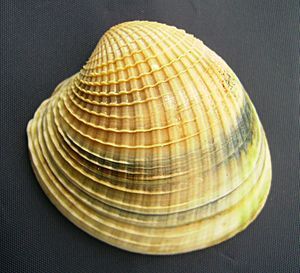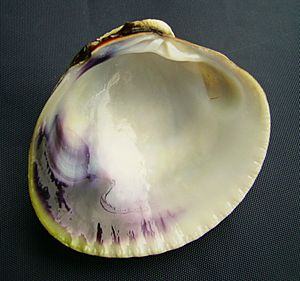Austrovenus stutchburyi facts for kids
Quick facts for kids Austrovenus stutchburyi |
|
|---|---|
 |
|
 |
|
| Scientific classification | |
| Synonyms | |
|
Chione stutchburyi |
The New Zealand cockle, also called the New Zealand little neck clam, is a type of edible clam found in the ocean. Its scientific name is Austrovenus stutchburyi. It's a bivalve mollusc, which means it's a soft-bodied animal with two shells that are hinged together. This cockle belongs to the family called Veneridae, also known as the Venus clams. In Māori, it's called tuangi in the North Island and tuaki in the South Island.
Contents
Where Do New Zealand Cockles Live?
New Zealand cockles make their homes in harbours and estuaries across New Zealand. These are places where rivers meet the sea.
Finding Their Home in the Water
Cockles live in areas that are either always covered by water (subtidal zone) or areas that are sometimes covered and sometimes exposed (intertidal zone).
- In the intertidal zone, they prefer to live between the low tide mark and the middle tide mark.
- They can't survive higher up on the beach because they would be out of the water for too long.
What Kind of Sand Do Cockles Like?
Cockles like to live in soft mud and fine sand.
- They need sand that isn't too fine, because very fine sand can actually suffocate them.
- This is why they often live in areas with slightly larger sand grains.
- Cockles bury themselves about 2 to 3 centimetres deep in the sand to stay safe.
How Do Cockles Protect Themselves?
Cockles have a soft body. This soft body is kept safe inside a strong shell. The shell protects them from being eaten, drying out, and strong waves.
Protection from Predators
It's hard for predators to break the shells of adult cockles.
- Some seabirds eat cockles by dropping them from high up. This smashes the shell so they can eat the soft body inside.
- Fish, like flounder, usually can't break the strong shells of adult cockles.
- Younger cockles have softer shells, so they are easier for predators to eat.
Staying Moist at Low Tide
If a cockle lives where the tide goes out, its shell closes very tightly.
- Special muscles, called abductor muscles, pull the shells shut.
- A small amount of water stays inside the shell. This keeps the cockle's body moist and stops it from drying out when the tide is out.
Surviving Strong Waves
Strong waves can sometimes pull cockles out of the sand.
- When a cockle is drifting in the water, its strong shell protects its soft body from getting hurt.

